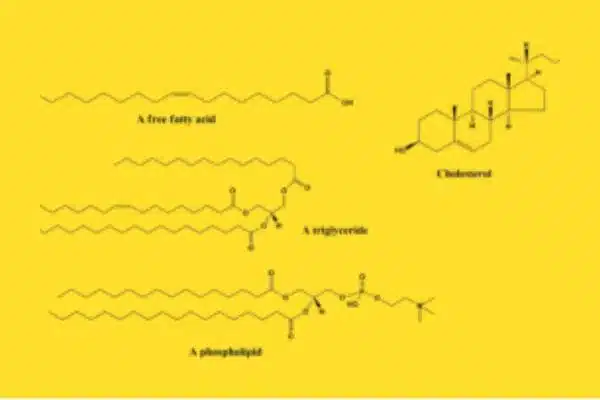
Aliphatic and monocyclic saturated hydrocarbons
Aliphatic and monocyclic saturated hydrocarbons in the molecular fossil record and their paleobiological interpretation. These are the most important biomarkers in the geological study. Because they are very easy to identify in the GCMS being a very simple structure. like n-alkane, short chain n-alkane, long chain n-alkane.
Classification of saturated hydrocarbons
| Biomarker | Biological and/or environmental interpretation | References |
|---|---|---|
| n-alkanes | ||
| outstanding concentrations of n15, n17 and n19 in early Paleozoic rocks | Gloeocapsomorpha Prisca, marine phytoplankton of uncertain affinity, probably an alga, identified in Cambrian-Devonian sediments but most prominent in Ordovician. Estonian kukersite is a typical source | Blokker et al., 2001, Fowler, 1992 |
| n-C27 with OEP1 | waxes derived from higher plants, terrestrial input, post-Silurian age | Hedberg, 1968, Tissot and Welte, 1984 |
| n-C40 | predominantly degradation products of aliphatic macromolecules such as algae an (marine, lacustrine), cutan, and suburban (terrestrial, plant-derived) | Allard et al., 2002, Killops et al., 2000 |
| Branched alkanes and acyclic isoprenoids | ||
| monomethylalkanes and dimethyl alkanes (MMA and DMA) | cyanobacteria both cultured and in mat communities from hypersaline and hydrothermal environments | Dembitsky et al., 2001, Kenig et al., 1995b, Koster et al., 1999, Shiea et al., 1990 |
| 5, 5-dimethyl alkanes with OEP1 (wrongly reported as 3, 7- or 3,w7-dimethyl alkanes) | these structures are widely and incorrectly assigned. Chemical synthesis of a 5, 5-diethyl alkane indicates this is a major series. Often occurs with other alkanes with quaternary carbon centers (BAQCs). Source organisms not known but commonly found in association with benthic microbial mats. | Arouri et al., 2000a, Arouri et al., 2000b, Kenig et al., 2002, Logan et al., 1999, Logan et al., 2001, Simons et al., 2002 |
| pristane (Pr) and phytane (Ph) | from chlorophylls of cyanobacteria, algae and plants, bacteriochlorophylls a and b of phototrophic bacteria, tocopherols, Ph: archaeal membrane lipids | Peters and Moldowan, 1993 |
| regular acyclic isoprenoids i-21 to i-30 | probable source is halophilic Archaea, abundant in evaporitic environments | Grice et al., 1998b |
| squalane (tail-tail C30 acyclic isoprenoid) | all organisms produce some squalene, most sedimentary squalane probably from Archaea. | Grice et al., 1998b |
| crocetane | archaea (anaerobic methane oxidizers), associated with sub-sea gas, gas hydrate and mud volcanoes | Bian et al., 2001, Thiel et al., 1999 |
| PMI (2,6,10,15,19-pentamethylicosane) | methanogenic and methanotrophic archaea | Elvert et al., 1999, Schouten et al., 1997, Thiel et al., 1999 |
| TMI (2,6,15,19-tetramethylicosane) | only reported from a mid-Cretaceous oceanic anoxic event, nonhyperthermophilic marine Crenarchaeota? | Kuypers et al., 2001 |
| C20, C25, C30 and C35 highly branched isoprenoids | unsaturated and polyunsaturated isoprenoid hydrocarbons are prominent biochemicals in some diatom taxa such as Rhizoselenia and Haslea | Sinninghe Damste et al., 1999a, Volkman et al., 1994, Belt et al., 2000, Rowland et al., 2001 |
| botryococcenes and botryococcanes, cyclobotryococcenes, polymethylsqualenes | the unsaturated, sometimes cyclic, biogenic hydrocarbons and their saturated fossil counterparts are diagnostic markers of the chlorophyte B. braunii and their preferred habitat of fresh to brackish water. | Huang et al., 1988, Metzger and Largeau, 1999, Summons et al., 2002 |
| Monocyclic saturated hydrocarbons | ||
| C42 – C46 cyclopentylalkanes with OEP1 | oils from marine environments, unknown biological source | Carlson et al., 1993, Hsieh and Philp, 2001 |
| C42 – C46 cyclopentylalkanes with no distinct carbon preference | oils from freshwater lacustrine settings, unknown biological source | same as above |
| C42 – C46 cyclopentylalkanes with strong EOP2 | oils from saline lacustrine settings, unknown biological source | same as above |
| cyclohexyl alkanes without predominance | formed during pyrolysis of biopolymers with long aliphatic carbon chains suggesting an origin from acyclic polymethylenic precursors | Gelin et al., 1994 |
| macrocyclic alkanes C15-C34 without preference | bitumens extracted from torbanites containing remains of B. braunii, fresh to brackish water | Audino et al., 2002 |




